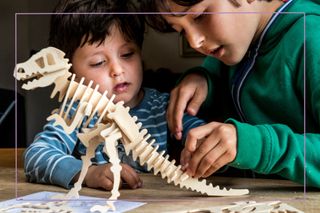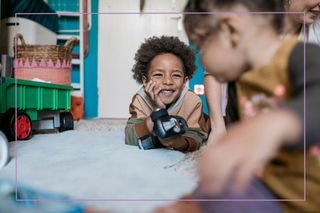Best sensory toys for babies from birth to 6 months 2024: 42 toys to help little ones discover the world around them
The best sensory toys deepen your child's development while stimulating their five senses - these are our top picks
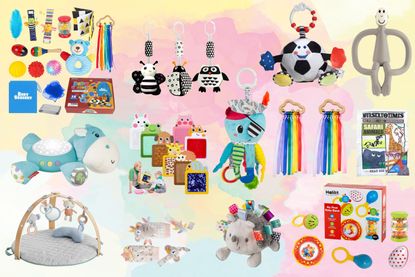
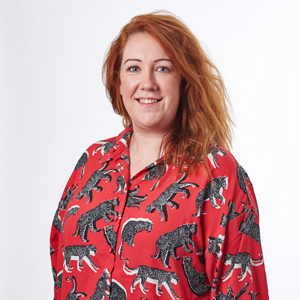
Incorporating the best sensory toys into playtime with your baby is a great way to help stimulate their five senses. When it comes to playing with a newborn, incorporating some sensory play can help your little one discover the world around them and help give their development a boost.
A sensory toy is one which is designed specifically to stimulate one or more of the five senses - touch, sight, hearing, smell and taste - sometimes more than one at a time - during play. These could be toys that have bright or contrasting colours, those that have a range of textures for little fingers to explore, those that light up or ones that crinkle or rattle when squeezed or shaken.
Child development expert Dr Amanda Gummer says: "Babies’ brains develop rapidly and they absorb far more of their environment that you might expect! As their senses start to mature, connections are made that form the basis of memories, getting them familiar with routines and making them feel safe and secure."
We've based this list of the best sensory toys for newborns up to six month olds, at which point they might move on to the best toys for six to 12 month olds, or stacking and nesting toys, on the experience of real mums, recommendations from experts, and wider consumer reviews. We've also made sure to include wooden options where possible as we commit to sharing more sustainable products with you.
Best sensory toys for newborns up to six months
Why you can trust GoodtoKnow.
1. High contrast toys
In your baby's first few weeks, they can only see in black, white and grey, so black and white toys that offer high contract can be great sensory toys for them to enjoy at this age.
In their first week, babies can only see about 30 centimetres and in very muted colours, which is where black and white toys that offer strong colour contrast come in. According to Consultant Paediatrician Dr Caroline Fertleman and author Simone Cave in their book Your Baby Week by Week: "His eye retina cells aren't yet fully developed, so colours look muted to your baby; a black-and-white mobile about the only 'toy' a newborn will notice."
But from around six weeks, you could see your little one become more engaged in play. Dr Fertleman adds: "From around now, your baby will enjoy watching things that move...Black and white will be the easiest for your baby to see, but he'll also be able to see primary colours..."

These pram toys are perfect for young babies as their eyesight develops thanks to the high contrast black and white colour scheme. Each toy is made from soft and plush material and also has a built-in bell which sounds whenever the toy is shaken, adding to the sensory experience. This set of three includes a ladybird, bee and an owl, but there are other variations available too.
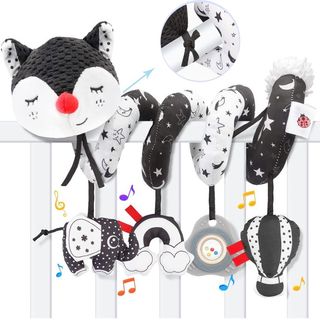
This fox-themed spiral toy is perfect for those weeks when your baby can only see in black and white. Easily wound round the bars of a cot or pushchair, it's made from soft material that tiny hands will love to explore. It also features multiple eye-catching pendants for your little one to discover, like squishable shapes, a squeaker, bird chirps and rotating bead balls.
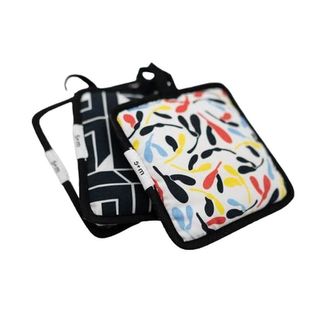
These squares are perfect for a bit of sensory play on the go as they easily fit into a handbag or changing bag. They're reversible too, with one size optimised for babies from birth up to four months, while the other is suitable for babies five months and older. As well having high contrast patterns, one square crinkles, one has a rattle, and one has a mirror, meaning lots of opportunities for sensory fun.
2. Crinkle books
Crinkle books are a great sensory toy for this age, as they make a fun sound as your little one works on strengthening their finger muscles. The bold and bright colours, mixed with the new sounds will delight your baby.
In Your Baby Week by Week, Dr Fertleman explains: "As your baby continues to learn how to use his hands he'll start to enjoy rattles or anything that makes a noise. He's also old enough to start making a link between what he's doing with his hands and what he hears and sees..."

With its bright colours and crinkle sounds, this soft book can withstand even the most excited scrunch from tiny hands. There's also a range of fun tail textures for little ones to explore as they learn about animals from the jungle. It's easy to wash too, should your little one want to put it in their mouth.
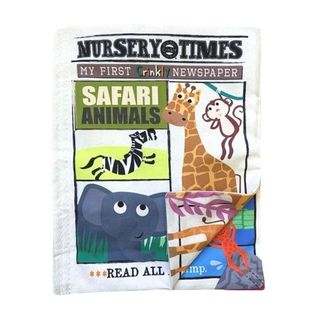
This soft cloth book is designed to look like a newspaper, with wonderfully crinkly pages that little ones will love to squeeze, while the colourful animals will give them something exciting to look at (and for parents to explain about as baby plays). Practical and lightweight, it's machine washable too.

Another brilliant soft book for little hands to explore, this one introduces your baby to farm animals, with lots of textures for them to discover, like a fluffy sheep's wool or a duck's felt beak. The bright colours are really engaging, and there's also a teether toy attached for when they want to engage in mouthing.
3. Lamaze toys
If other new parent's haven't yet told you about Captain Calamari, then make sure you fill them in, stat! Part of a range of Lamaze toys to stimulate your baby's senses, the Lamaze range of toys can also be clipped on to a pushchair for sensory play on the go.
The toys in the range (we've picked our favourite below) are brightly coloured, and feature a range of fun textures for your little one to explore, including various fabric textures, crinkly parts and a rattle. The cute characters also foster early imaginative play and can aid your child's emotional development too.

Captain Calamari is something of a celebrity amongst the newborn set. And it's not hard to see why. He's got a fun peekaboo eye patch and captain's hat, as well as a mirror and eight knotty legs with rings and a rattle - lots of textures that little hands will love to explore. Make sure he's clipped to the pram (or your bag) before you leave the house with your baby.
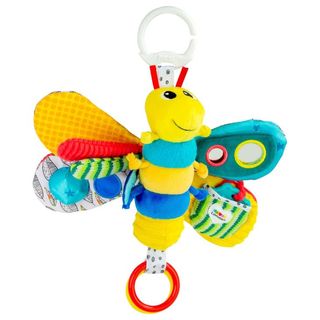
With its crinkly wings, mirror, plastic rings and a squeaker, Freddie the Firefly offer loads of stimulation for your baby's senses. It also features a teether, which not only allows your little one to chew and bite as they play, but can also help soothe them when they start teething.

Easily attached to your baby's pram, cot or baby gym, My Friend Emily has loads of textures for your tiny human to explore, from her crinkly dress and sequin hat, to her woolly tights and the rattle she holds. Brightly coloured, with an engaging face, it's not wonder she's so popular, with almost 4,000 five-star reviews on Amazon alone.
4. Activity play mats
Play mats with different textures are perfect for babies to help them develop their sensory perception. These kinds of mats also foster fine motor skill development as your little one strengthens their finger muscles as they grab and touch. As they grow, you can get their feet involved in the sensory exploration too.

These mats can be hit or miss with babies - some love them, others aren't fussed. But if you want to try them out, they are a great option for a bit of tactile play. Suitable from three months, you simply fill the middle section with water and the outer tube with air, and your little one can enjoy some tummy time and sensory play at the same time.
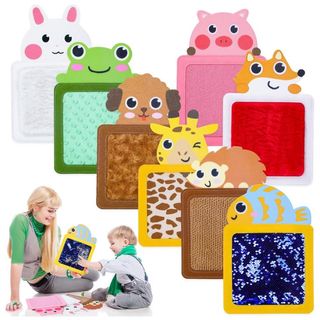
The eight different sensory mats in this set are all inspired by animals, whose likeness are included on the mats. From the smooth texture of a fox's fur to the prickly feel of a hedgehog, these mats are a great way to engage your baby in storytelling while they discover the array of different textures.
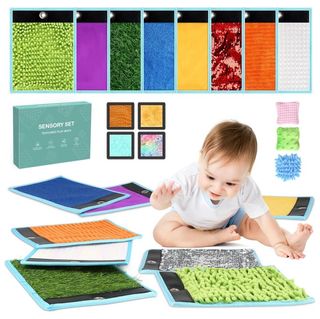
This 15-piece sensory play set includes eight sensory floor tiles, four sensory mats and three sensory beans bags, so there is lots to keep your little one entertained (and as they grow). There are a range of textures for your baby to explore - and the mats are durable and easily wiped clean.
5. Teething toys
Teething toys are great for babies, beyond providing relief when their teeth start coming through, a process which can start from around 15 weeks (even if the teeth don't actually appear for a while). But babies also love putting things in their mouths as a form of sensory exploration.
You can also try popping a teething toy in the fridge for a while before giving it to your baby, for an experience of a different temperature (or to help sooth sore gums) but do check the instructions of the teething toy first.
GoodtoKnow's Editor and mum Anna Bailey bought all of these teethers for her daughter and says: "Freddie has all of these, and loved them all. Matchstick Monkey has been especially good on the go, as we could loop a tie around his arm and clip it to Freddie’s outfit. She also loves the crinkle noise that the Hungry Caterpillar makes."
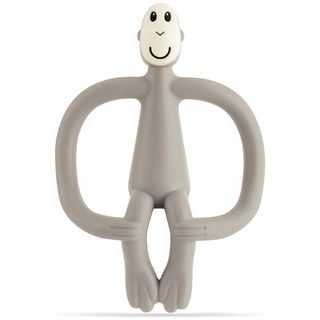
Suitable from three moths and available in a variety of colours, Matchstick Monkey is a lightweight teether that is easy for little hands to hold. There are small bumps on the back of the monkey's head which are not only an interesting texture for your baby to explore with their fingers or mouth, but it can also be used for the application of baby-safe teething gel if and when your baby needs it.

With it's bright colours and rattle, this Very Hungry Caterpillar toy is a great option for sensory play and is suitable from birth. It's eye-catching, easy to hold, and has various textures for your baby to discover. There's also a textured teether tail to help with your baby's sensory exploration and to help ease any discomfort when they start teething. If you have the book, this teether rattle is also a brilliant story time companion.
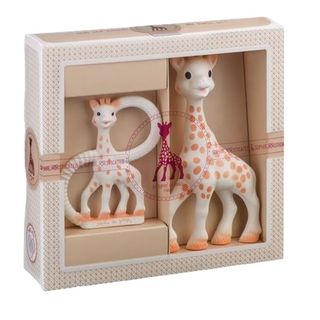
Sophie La Girafe has been hugely popular in recent years, thanks to the cute design that is lightweight enough for little hands to hold. There are lots of parts for your baby to chew on as they play, or to soothe sore gums when they start teething. This set includes the original Sophie La Giraffe, and teething ring version, with textured handles that little ones will love to discover.
6. Baby shakers
Baby shakers are excellent sensory toys - they're usually brightly coloured, textured, and make a satisfying noise. And babies will love exploring these objects with their eyes, hands and mouth.
As your baby learns to intentionally grasp objects and becomes more controlled with their arm movements, baby shakers can help your baby start to understand the concept of cause and effect, which is a critical part of their cognitive development.
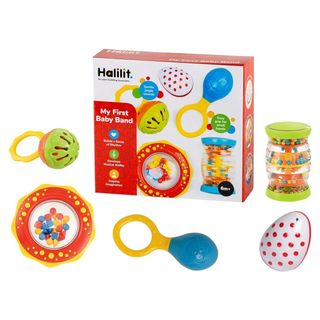
This set falls just within the age range suitability of this article, being suited to babies when they reach six months. The set includes a range of colourful toys egg shaker, cage bell, baby maraca, tube shaker and a fun rattle, so there is plenty to stimulate your little one's senses.
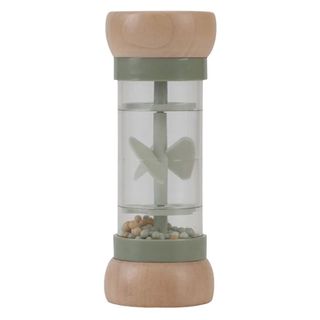
For something a little more design-conscious, this wooden topped rattle hits the mark, and it's under £10. Easy for little hands to hold, this rattle sounds like rain, which can not only help to to stimulate your baby's senses, but also soothe them before their nap. It's best for babies aged three months and older.
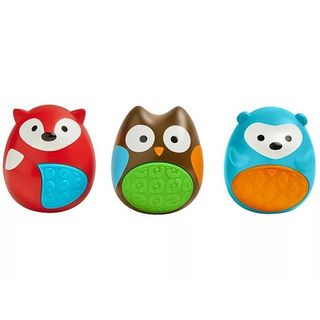
Suitable from three months, this egg shaker trio leads to seriously egg-cellent sensory play. Just the right size for little hands, each shaker has its own distinctive rattle sound and playful textures for tiny fingers to explore. The shakers can be grabbed, shaken or rolled across the floor, meaning loads of ways to play.
7. Light up and flashing toys
Toys that light up or flash are super engaging for babies, stimulating their senses, especially if you close the curtains while playing. They can help to promote your baby's eye coordination as they trying to follow the lights with their eyes.

Stimulate your baby's senses as they hit three months with this sun shaker activity toy. Not only can your little one bat and spin the sunshine to make it move, they can activate music and lights by shaking it, which not only excites their senses, but also helps introduce them to the idea of cause and effect.
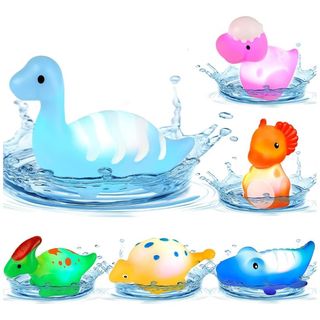
Level up bath time with these light-up floating dinosaur toys. Suitable from five months, these dinosaurs are soft and durable enough for little hands to grip and squeeze, and are all different shapes and sizes, so there's plenty for your baby to discover. The built-in LED lights also flash and change colours!
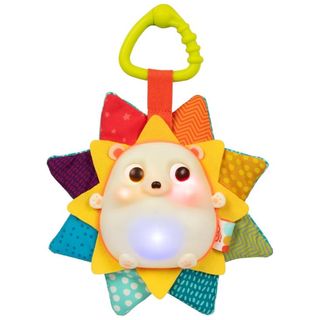
With textured and crinkly tabs, glowing lights and soothing music this hedgehog toy is a delight for your baby's senses. It has a handy clip so you can take it out and about with you without worrying about losing it, and it can be taken apart to allow for easy washing of the fabric parts.
8. Wrist rattles and socks
Turn your baby's discovery of their own hands and feet into a sensory experience with the addition or wrist rattles and socks. They're soft and light enough that they won't hamper your little one's movement, but the contrasting colours and fun sounds will make your baby's exploring even more exciting.
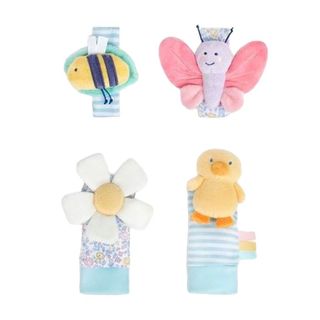
Wrist rattles and socks turn any movement your baby makes into a sensory experience. With every movement, of their arms and legs, the rattle will sound, meaning endless entertainment for your little one. The attached plush animals provide another fascinating element for your baby to discover.
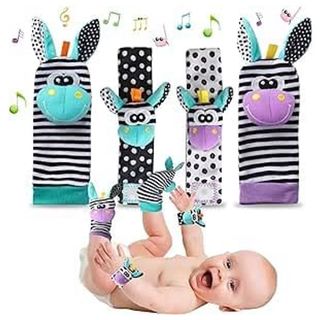
With crinkly textures, rattle sounds and black and white pattern, these wrist rattles and socks are a treat for your baby's senses. The colourful characters will encourage your baby to reach, grab and kick to stimulate hand, eye and foot coordination. They fit securely onto your baby's limbs with Velcro, you don't have to worry about them falling off mid-play.
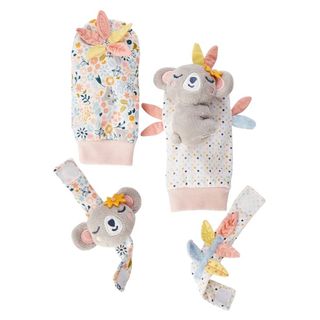
This adorable koala wrist rattle and foot finder set makes a great gift for a newborn baby and an effective introduction to sensory play. Little fingers will love exploring the 3D koala shape, while every movement they make causes fun sounds for them to discover. As they play, they will start to understand cause and effect too.
9. Things for the play box
You might take your baby to a baby sensory class in your local area, but there's nothing stopping you creating your own class at home. Just stock up on a few of these essentials and you and your baby can bond in the comfort of your own home while enjoying some sensory play. Think brightly-coloured feathers, super-soft scarves and silky ribbons.
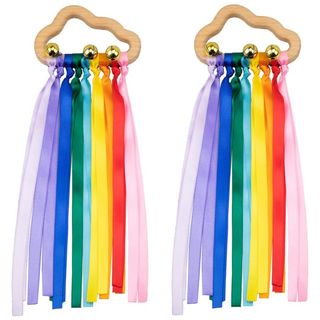
Perfect for small hands to grip, these wooden ribbon toys are a brilliant way to stimulate their senses, thanks to silky, colourful strands, smooth wood and jangly bells. The wood is safe for your baby to chew on as they explore with their mouth, and the multi-coloured ribbons are not only visually exciting, but can also be traced over baby's skin during tactile play.
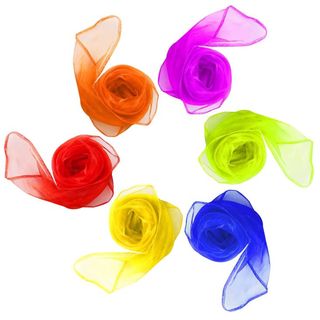
Made from a silk-like chiffon material, these scarves are soft and brightly coloured so they'll easily grab your baby's attention. They're thin enough to breathe through, so you can safely run it over your baby's face when playing (although make sure you wash the scarves first). They are also light enough for young babies to be able to grab and wave around too.

GoodtoKnow's Editor Anna Bailey bought this set for her daughter and says: "This is such great value for money, and a perfect way to introduce sensory toys to a young baby. You need to get involved with these toys, so it’s great for bonding and watching your baby’s reaction. Freddie loved the feathers on her toes.”
10. Textured balls
As well as offering fun textures for little fingers to explore, brightly coloured ball-shaped toys can also help your baby to work on their eye coordination as they follow the ball's movement.
For young babies, soft and plush textured balls are best to avoid any accidental injury.
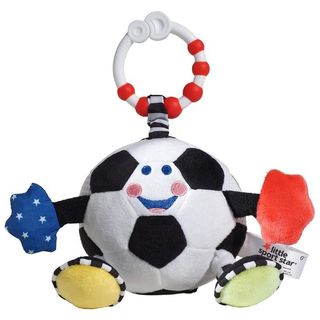
Soft, plush and infinitely squishable, this black and white football toy not only excites your baby's senses, but also encourages them to develop their hand-eye coordination and motor skills. It also jingles when shaken and can be easily clipped onto a pram or bag for sensory fun on the go.
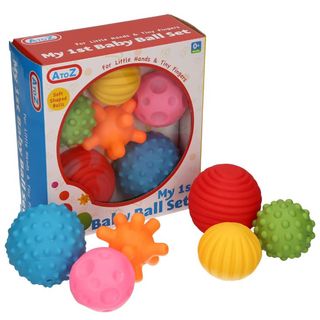
These lightweight, brightly coloured balls offer six different textures for your little one to discover, and as they grip and squeeze them, they squeak. Mum-of-one Anna says: "These were recommended by a friend, and did not disappoint. Freddie was fascinated with the texture, especially the spikey one - and loves playing with them in the bath as well."
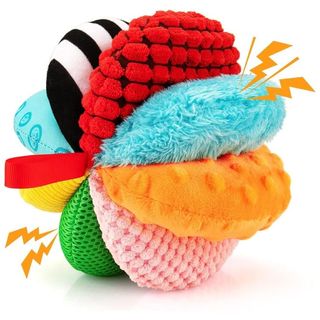
With eight different textures for your baby to discover, including corduroy and fleece, as well as a range of colours and patterns, this plush sensory ball is well worth adding to the toy collection. It also makes various sounds, from crinkles to bells and squeakers, meaning lots of fun for your little one.
11. Tag toys
When it comes to calming sensory play, comforters or blankets with silky smooth tags for little ones to grasp can be very soothing, while helping them develop their fine motor skills as they try to rub the silky tags. If you want to make the play a bit more energetic, you can always use the blanket in a game of peek-a-boo too.
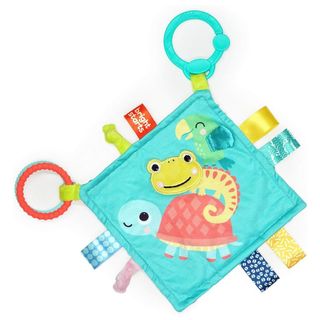
With its sensory tags, knots and rings, there is plenty in this colourful blanket to engage your baby's senses. Suitable from birth, it helps promote soothing sensory play which can help calm your baby before nap time. Rubbing the silky tags can help to develop their hand-eye coordination skills too.
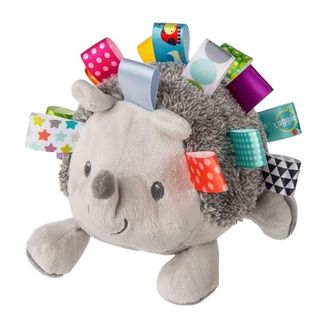
With multiple eye-catching and silky tags to pull and hold, this cute cuddly hedgehog toy makes a great gift for a newborn. They'll love to explore the different colours and patterns, and the satin tags can help calm baby, while also stimulating their senses. It's easy to keep clean too - just pop it in the washing machine and leave it to air dry.
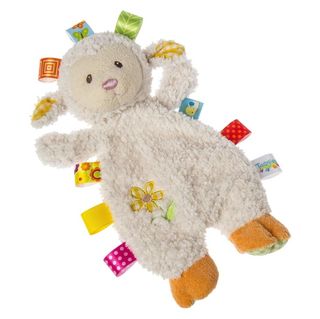
With a fluffy white textured fabric covering the lamb's body, Sherbert the Lamb also has a flower applique and gingham patches that baby's will love to touch and learn. For an added sensory experience, the plush toy features multiple satin loops for your baby to interact with as they play.
12. Baby gyms
Baby gyms are another great option for some sensory play time, thanks to sound effects, a range of textures, bright colours and fun toys to develop the muscles in their hands and their fine motor skills.
They help your baby explore the world around them, safely, and can give parents some time with their hands-free. We've picked some of our favourites below, but you can always check out our list of the best baby gyms for more detailed information and reviews.
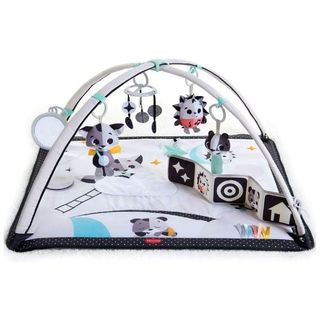
Black and white, with a host of engaging activities to help your baby discover the world around them, this baby gym was a bit with our parent tester Ursula and her daughter, Violet: “This is a really brilliant play mat and my five-month-old really enjoys using it,” she said. The mat is a decent size (it can even fit two babies on) but at the same time “it doesn’t take up too much space."

With its wooden toy bar, this is a suitable option for those looking for something more sustainable than plastic alternatives. With a reversible duvet-like cushion, this baby gym also has six removable toys; including a plush bear, bead rattle, rubber apple toy and a wooden ring. It can be folded in half for compact storage.

Another wooden option, this baby gym includes a range of toys in soft colours including an activity cube, a plush bear and a baby-safe mirror for your baby to discover. The colour palette might be more muted, but the polka dot patterns on the cushion and activity cube are still striking enough to stimulate your baby's mind as they play.
13. Light projectors
Less of a toy that your baby can play with themselves, and more of a sensory experience they can enjoy, light projectors are hugely popular at baby sensory groups, and are worthwhile having a home too.

Easily attached to the side of your baby's cot, this light can be switched quickly between night light and projector mode. Able to project a starry night sky onto the ceiling and surrounding walls for a sensory experience for your baby to enjoy, this device also has sound sensors to detect if your baby wakes and start playing soothing music and project the stars to lull your little one back to sleep.

This hippo projects starry lights from the dome on its back, creating a really immersive sensory experience for your baby in the comfort of your own home. This relaxing form of sensory play can help ready your baby for sleep, and the hippo's sound functions, including lullabies, nature sounds and white noise can help send your baby off to dreamland.
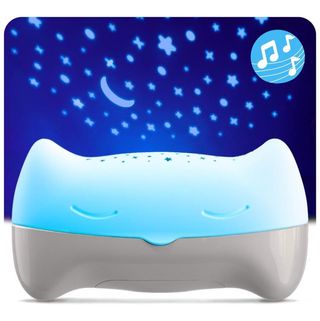
With six soothing and calming sounds, this projector will extend an array of alternating colourful lights around baby's room. While the lights will engage your baby's senses, used before bedtime they can help establish a sleep routine with your baby, where they start to understand that when the lights come on, it's time to wind down for bed.
14. Sensory toy kits
If you're not sure where to start with sensory toys, or want to buy a selection to see what your baby responds to best, then a sensory toy kit is a worthwhile investment. They can also be perfect kits to keep at the grandparents' to (slightly) reduce how much stuff you have to take (or remember to take) should you go to visit.
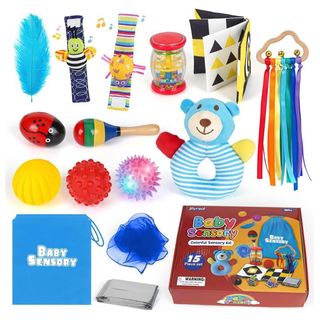
If you're looking for value for money, this set includes a double sided soft book, two wrist rattles, a wooden ribbon ring, a plush rattle, two wooden maracas, a rainmaker, two texture balls, a glow ball, sensory scarf, foil blanket, feather and a storage bag to keep it all in.
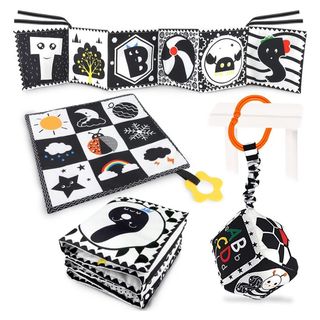
High contrast black and white toys, with pops of bright colours, mean this set is perfect for newborns and will keep their attention as they grow and their vision develops. To stimulate your baby's auditory sense, each toy offers a different sound for them to discover - a squeaker, a bell, or a fun crinkle noise.
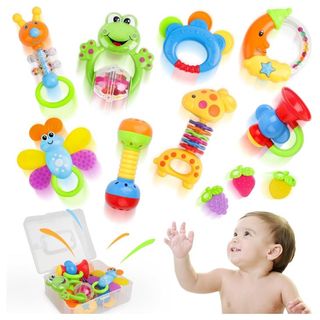
Lightweight and the perfect size for little hands to grasp and shake, all of the toys in this set are made from non-toxic plastic and silicone so your baby can safely explore them with their hands and mouth. With parts to squeeze, touch, shake and crinkle, this collection is a treat for your baby's sensory development.
Why are sensory toys good for babies?
Sensory toys are really effective for babies by helping them to discover and explore the world around them. Child development expert, and founder of the Good Play Guide, Dr Amanda Gummer, explains: "Babies at this age love exploring different textures to stimulate their sense of touch and encourage sensory exploration."
Talking to your newborn while playing with sensory toys can have added benefits too, as Dr Gummer goes on to explain: "Talking to your baby while playing together and using natural speech patterns has been shown to help language development in later months and the rhythm and sound of musical toys will facilitate language learning, listening skills and can help with relaxation."
When it comes to choosing the best sensory toys, Karen Clarke, Brand Director at Smart Toys and Games told GoodtoKnow: "Babies like toys that are colourful and creative, and parents/guardians are increasingly searching for quality toys that help develop key skills, have an educational element, are good value for money and most importantly are safe!
"It’s amazing to watch a child’s development as they are continuously learning through play. For example, developing vision, hand-eye coordination, cognitive language, motor skills, spatial awareness, concentration, creativity and imagination, as well as aspects in toys that allow children to learn how to problem solve or learn to engage with others."
When should babies start playing with sensory toys?
Babies can start engaging in sensory play from birth, but they type of play or toys you choose will vary depending on their age. High-contrast black and white mobiles or pram toys are perfect for their first few weeks, while baby shakers are more suitable when they can start to grasp objects intentionally and have more control over their hand and arm movements.
Similarly, younger babies might enjoy the sensation of a feather being ticked over their skin, but as they grow, they might also enjoy something that they can squish and crinkle in their own hands.
As your child grows up, they might start to enjoy fizzing bath bombs or slime as a form of sensory play.
What to look for in a good sensory toy
If you're looking for a good sensory toy for your baby to play with, there are a few key things to look out for:
- Bright or high-contrasting colours
- A range of textures for curious hands to explore
- Toys that light up
- Toys that crinkle or make sounds when shaken or scrunched
Dr Amanda Gummer adds: "When choosing toys for your baby it’s essential to consider the baby’s age, stage of development and of course. My Good Play Guide is a resource created by myself and accredited child development and play experts, that helps identify toys that support key areas of development such as cognitive, physical, and emotional growth."
How we chose the best sensory toys
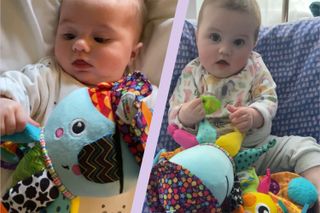
To compile this list of sensory toys, we spoke to multiple child development and play experts, as well as consulting expert baby guides, to make sure the toys on this curated list made the cut and were developmentally suitable. We also had advice from mums and dads who regularly engaged in sensory play with their children, including GoodtoKnow's Editor Anna Bailey who bought and tested many toys on this list with her daughter, Freddie. Anna adds: "Freddie was adorable as a sleepy newborn, but it was so exciting watching her transition into a more alert baby. I loved watching her take in the world, and really wanted to encourage all that sensory exploration. She loved so many of these toys, especially the Jungly Tails books, and Sophie the Giraffe - but hands down, her favourite was Captain Calamari. She’s 16 months old now, and she still loves pulling him out of the toy box. I’ve bought him for a few friends who've recently had babies, and he’s a winner every time.”
We have also made sure that everything on this list is suitable for babies from birth up until they are six months old. Additionally, we have tried to include as many wooden or eco-friendly options as possible as we commit to promoting more sustainable product selections.
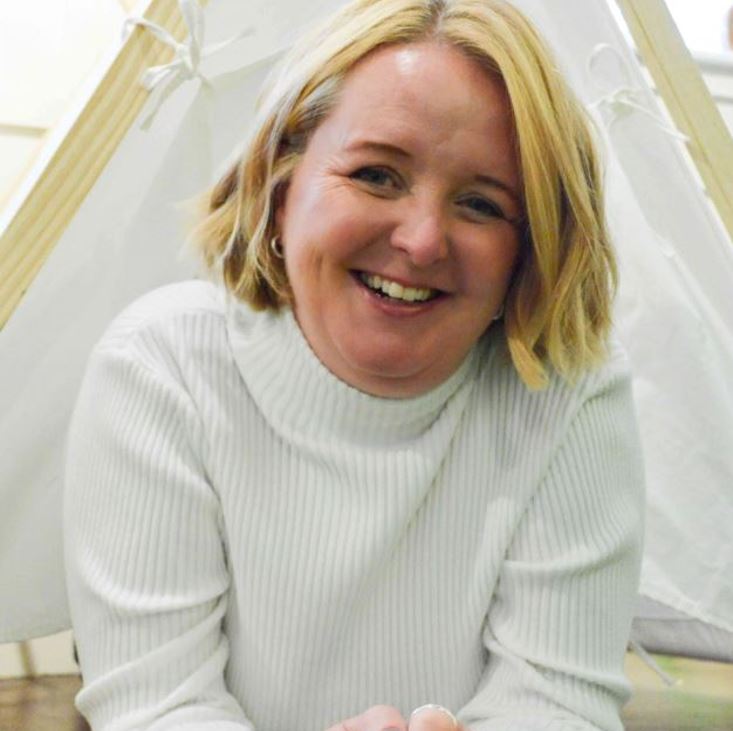
Dr Amanda Gummer has a PhD in Neuropsychology, the Postgraduate Certificate in Higher Education and more than 20 years’ experience working with children and families. As such, she is renowned as an expert on all aspects of child development, including toys and play. In 2012, she founded The Good Play Guide, an independent, expert accreditation service for children’s products, including toys, apps and more.
Continue reading
GoodtoKnow Newsletter
Parenting advice, hot topics, best buys and family finance tips delivered straight to your inbox.

Sarah is GoodtoKnow’s Consumer Writer & Money Editor and is passionate about helping mums save money wherever they can - whether that's spending wisely on toys and kidswear or keeping on top of the latest news around childcare costs, child benefit, the motherhood penalty. A writer, journalist and editor with more than 15 years' experience, Sarah is all about the latest toy trends and is always on the look out for toys for her nephew or Goddaughters so that she remains one of their favourite grown ups. When not writing about money or best buys, Sarah can be found hanging out with her rockstar dog Pepsi, getting opinionated about a movie or learning British Sign Language.
-
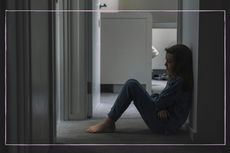 Kids with ADHD receive more 'negative messages' than neurotypical kids - 10 child psychologist tips to help parents support them
Kids with ADHD receive more 'negative messages' than neurotypical kids - 10 child psychologist tips to help parents support themExperts have shared tips to help caregivers better support kids with ADHD
By Charlie Elizabeth Culverhouse Published
-
 Mum of nine-month-old who died after choking at nursery didn’t want to ‘appear pushy’ by asking staff to cut up his food
Mum of nine-month-old who died after choking at nursery didn’t want to ‘appear pushy’ by asking staff to cut up his foodThe parents of the nine-month-old are now raising awareness to help parents know what to do when children are choking
By Charlie Elizabeth Culverhouse Published
-
 Musical toys for babies and toddlers: 12 brilliant buys for 6 months to 3 year olds
Musical toys for babies and toddlers: 12 brilliant buys for 6 months to 3 year oldsIf you're looking for musical toys for your baby or toddler, we've found some amazing options, including a Fisher-Price classic
By Sarah Handley Published
-
 I've found the perfect kids' sun lounger and you can get £20 off with this promo code
I've found the perfect kids' sun lounger and you can get £20 off with this promo codeA kids' sun lounger is the perfect accessory for a sunny weekend in the garden
By Heidi Scrimgeour Published
-
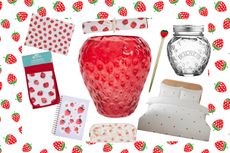 Strawberry vase mania is back! Fruity homewares from The Range are going viral all over again - here's everything our Shopping Editor wants
Strawberry vase mania is back! Fruity homewares from The Range are going viral all over again - here's everything our Shopping Editor wantsStrawberry-themed homewares from The Range are going viral - here's everything we're buying
By Heidi Scrimgeour Published
-
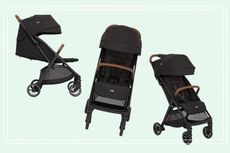 We tested the new Joie Pact Pro stroller and we won't be going back to our old set of wheels - here's why
We tested the new Joie Pact Pro stroller and we won't be going back to our old set of wheels - here's whyThe Pact Pro by Joie is the perfect pushchair for holidays but tough enough for daily life
By Heidi Scrimgeour Published
-
 9 slime toys kids will love (even if their parents don't), including a no-residue option for mess-free play
9 slime toys kids will love (even if their parents don't), including a no-residue option for mess-free playSlime toys are a great form of sensory play - we've picked nine top-rated options to keep them entertained and the mess to a minimum
By Sarah Handley Published
-
 18 toys for £10 or less, including Amazon's #1 bestselling toy, and the most popular toy of 2023
18 toys for £10 or less, including Amazon's #1 bestselling toy, and the most popular toy of 2023Looking for a gift for a child? Check out our pick of the best toys under £10 that you can be sure kids will love
By Sarah Handley Published
-
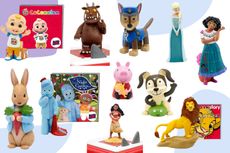 Most popular Tonies ever: 11 bestsellers, plus one we predict will be huge
Most popular Tonies ever: 11 bestsellers, plus one we predict will be hugeFrom Igglepiggle to Encanto, these are the bestselling Tonies to help kickstart an epic audio character collection
By Sarah Handley Published
-
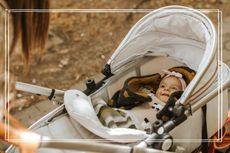 Why do babies need to lie flat in a pram?
Why do babies need to lie flat in a pram?Wondering why babies need to lie flat? Experts reveal all — plus whether or not a baby should sleep in a pram
By Charlotte Duck Published
